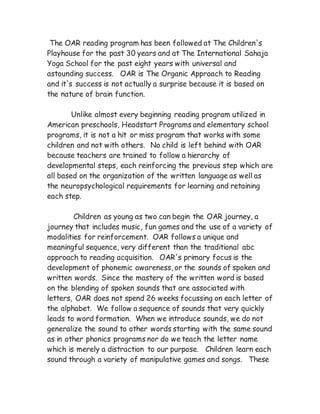
How the OAR reading program develops phonemic awareness and early reading skills
- 1. The OAR reading program has been followed at The Children's Playhouse for the past 30 years and at The International Sahaja Yoga School for the past eight years with universal and astounding success. OAR is The Organic Approach to Reading and it's success is not actually a surprise because it is based on the nature of brain function. Unlike almost every beginning reading program utilized in American preschools, Headstart Programs and elementary school programs, it is not a hit or miss program that works with some children and not with others. No child is left behind with OAR because teachers are trained to follow a hierarchy of developmental steps, each reinforcing the previous step which are all based on the organization of the written language as well as the neuropsychological requirements for learning and retaining each step. Children as young as two can begin the OAR journey, a journey that includes music, fun games and the use of a variety of modalities for reinforcement. OAR follows a unique and meaningful sequence, very different than the traditional abc approach to reading acquisition. OAR's primary focus is the development of phonemic awareness, or the sounds of spoken and written words. Since the mastery of the written word is based on the blending of spoken sounds that are associated with letters, OAR does not spend 26 weeks focussing on each letter of the alphabet. We follow a sequence of sounds that very quickly leads to word formation. When we introduce sounds, we do not generalize the sound to other words starting with the same sound as in other phonics programs nor do we teach the letter name which is merely a distraction to our purpose. Children learn each sound through a variety of manipulative games and songs. These
- 2. activities reinforce the associations that have taken place neurologically. Children at this stage know nothing about blending sounds - a challenging brain function initially. They nevertheless are introduced to the concept that sounds can be blended to make words after the first three sounds are introduced. As more sounds are learned, the children are shown how more words can be made. Gradually they begin the process of blending sounds into words. A door has been opened. Sounds continue to be introduced, following a logical sequence that leads to the discovery of other words that can be made. Letter squares gradually replace the picture/sounds that have become our friends. More games and songs are introduced to establish and reinforce the newly acquired skill of sound blending. Once this skill has been mastered, children soar ahead, excited with their mastery of the fundamental skill required for reading acquisition. You will notice that "sight words" have not been mentioned. It is only after there is a basic vocabulary of about 25 words that can be read, through sound blending, not rote memorization, that a few sight words are introduced for the purpose of reading sentences. Wahlah - a reader is born! And this reader may be under age 4. OAR also introduces writing, following the same recognition of the neurological requirements to master the written word. Written letters are organized into four basic groups of similar patterns so that they are not seen as 26 discreet forms to learn. Pre-writing skills are established before the delicate art of printing is introduced.